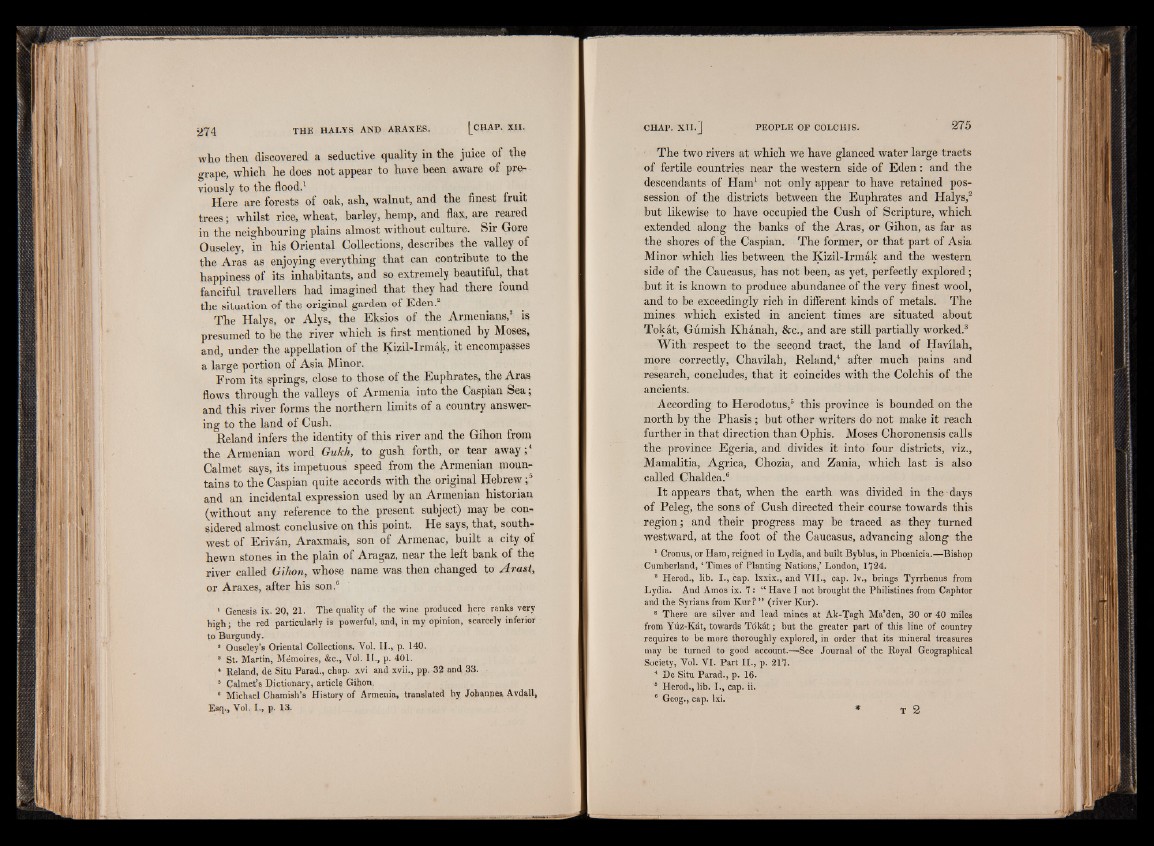
who then discovered a seductive quality in the juice of the
grape, which he does not appear to have been aware of previously
to the flood.1
Here are forests of oak, ash, walnut, and the finest fruit
trees ; whilst rice, wheat, barley, hemp, and flax, are reared
in the neighbouring plains almost without culture. Sir Gore
Ouseley, in his Oriental Collections, describes the valley of
the Aras as enjoying everything that can contribute to the
happiness of its inhabitants, and so extremely beautiful, that
fanciful travellers had imagined that they had there found
the situation of the original garden of Eden.2
The Halys, or Alys, the Eksios of the Armenians,3 is
presumed to be the river which is first mentioned by Moses,
and, under the appellation of the Kizil-Irmak, it encompasses
a large portion of Asia Minor.
From its springs, close to those of the Euphrates, the Aras
flows through the valleys of Armenia into the Caspian Sea ;
and this river forms the northern limits of a country answering
to the land of Cush.
Reland infers the identity of this river and the Gihon from
the Armenian word Gukh, to gush forth, or tear away ;
Calmet says, its impetuous speed from the Armenian mountains
to the Caspian quite accords with the original Hebrew ;J
and an incidental expression used by an Armenian historian
(without any reference to the present subject) may be considered
almost conclusive on this point. He says, that, southwest
of Erivân, Araxmais, son of Armenac, built a city of
hewn stones in the plain of Aragaz, near the left bank of the
river called Gihon, whose name was then changed to Arast,
or Araxes, after his son.6
1 Genesis ix. 20, 21. The quality of the wine produced, here ranks very
high ; the red particularly is powerful, and, in my opinion, scarcely inferior
to Burgundy.
* Ouseley’s Oriental Collections, Vol. II., p. 140.
3 St. Martin, Mémoires, &c., Vol. II., p. 401.
* Reland, de Situ Parad., chap. xvi and xvii., pp. 32 and 33.
5 Calmet’s Dictionary, article Gihon.
6 Michael Chamish’s History of Armenia, translated hy Johannes Avdall,
Esq., Vol. I., p. 13.
The two rivers at which we have glanced water large tracts
of fertile countries near the western side of Eden: and the
descendants of Ham1 not only appear to have retained possession
of the districts between the Euphrates and Halys,2
but likewise to have occupied the Cush of Scripture, which
extended along the banks of the Aras, or Gihon, as far as
the shores of the Caspian. The former, or that part of Asia
Minor which lies between the Kizil-Irmak and the western
side of the Caucasus, has not been, as yet, perfectly explored;
but it is known to produce abundance of the very finest wool,
and to be exceedingly rich in different kinds of metals. The
mines which existed in ancient times are situated about
Tokat, Gumish Khanah, &c., and are still partially worked.3
With respect to the second tract, the land of Havilah,
more correctly, Chavilah, Reland,4 after much pains and
research, concludes, that it coincides with the Colchis of the
ancients.
According to Herodotus,5 this province is bounded on the
north by the Phasis ; but other writers do not make it reach
further in that direction than Ophis. Moses Choronensis calls
the province Egeria, and divides it into four districts, viz.,
Mamalitia, Agrica, Chozia, and Zania, which last is also
called Chaldea.6
It appears that, when the earth was divided in the • days
of Peleg, the sons of Cush directed their course towards this
region; and their progress may be traced as they turned
westward, at the foot of the Caucasus, advancing along the
1 Cronus, or Ham, reigned in Lydia, and built Byblus, in Phoenicia.—Bishop
Cumberland, ‘Times of Planting Nations,’ London, 1724.
3 Herod., lib. I., cap. lxxix., and VII., cap. lv., brings Tyrrhenus from
Lydia. And Amos ix. 7 : “ Have I not brought the Philistines from Gaphtor
and the Syrians from Kur? ” (river Kur).
8 There are silver and lead mines at Ak-Tagh Ma’den, 30 or 40 miles
from Yuz-KAt, towards Tdkat; but the greater part of this line of country
requires to be more thoroughly explored, in order that its mineral treasures
may be turned to good account.—See Journal of the Royal Geographical
Society, Vol. VI. Part II., p. 217.
4 De Situ Parad., p. 16.
3 Herod., lib. I., cap. ii.
6 Geog., cap. lxi.
# T 2